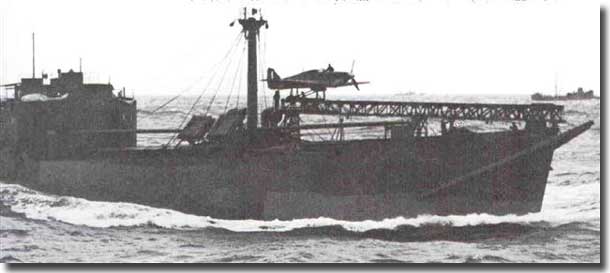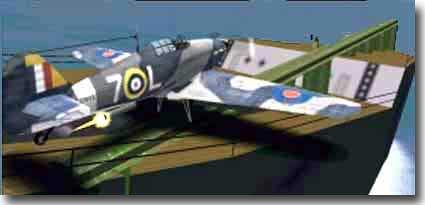The Development of the Catapult Armed Merchantman ( CAM Ships. )
Introduction.
In a desperate attempt to close the gap in the Atlantic Ocean that could not be covered by Allied aircraft flying west from England, and east from Canada, the concept of the Auxiliary Fighter Catapult Ships under the White Ensign, and the Catapult Armed Merchantmen ( CAM ships ) sailing under the Red Duster was conceived and born.

Hurricane on Catapult of CAM ship
1. Auxiliary Fighter Catapult Ships.
The Pegasus Class, consisted of Ariguani, Maplin, Patia, Pegasus and Springbank. This class of ship was converted from merchant ships in an attempt to combat the long range German Folke Wulf 200 Condor aircraft, which exploited the gap in mid Atlantic Ocean, here, Allied aircraft could not fly, it was beyond their range.
These German reconnaissance aircraft used this lack of air cover to home in their U-Boat wolf packs which had a field day with our convoys flowing both east and west, maintaining the vital life line to Britain.
First Catapult launched aircraft.
It took place a long time ago, Lieutenant Commander H.H. Mastin, on the 16th. of July in 1916, was launched from a moving ship, USS North Carolina, in his Curtiss AB-3 flying boat. In WW2, the first off a catapult ship was Lieutenant Birrell in 1941.
HMS Springbank.
One of the few of this new type of Fighter Catapult ships, Springbank was built for Merchant ship service in 1926. The Royal Navy acquired her in 1940, and converted this vessel into an AA ship with four twin High Angle 4 inch turrets, two sets of 20mm pom poms, and in 1941, fitted a cordite powered catapult amidships. A two seater Fulmar Naval Fighter squatted on this catapult.
Springbank launched this fighter on the 18th. of September 1941 whilst escorting convoy HG 73 from Gibraltar to Liverpool over the 17th. of September/ 1st. of October. The convoy was made up of 25 ships, and was attacked by German U-Boats, U-124, U-201, and U-203, each of them sank three ships from this convoy, to total some 20,652 tons.
The Fulmar attacked the German aircraft homing in its fellow U-boats, but it managed to escape, the Fulmar pilot did not in this case have to ditch, he made it to Gibraltar, only to find that all of his guns but one, had jammed during his attack, due to faulty ammunition. How galling for him, here he is risking his life in a hazardous operation, going into combat, to be let down by faulty ammunition, how reprehensible is that?
Springbank is torpedoed.
U-201 torpedoed Springbank at 0208 ( 2.08 AM ) on the 27th. of September, and HMS Jasmine went alongside to take off her survivors, and finally sank the mortally stricken ship by gunfire.
Fate of all three U-Boats.
U-124 was sunk with the loss of 53 crew in April 1943, by the Corvette Stonecroft, and the Sloop, Black Swan.
U-201 was sunk with all 49 crew on the 17th. of February 1943 off Newfoundland by HMS Viscount.
U-203 came to grief on the 25th. of April in 1943, when bombs from an aircraft flown from the Escort Carrier HMS Biter , and depth charges from the destroyer HMS Pathfinder accounted for the third U-Boat that had attacked Convoy HG 73 back in September 1941.

A Hurricane sitting on the Catapult of a CAM ship, waiting to go.
Mike Dunne in Sydney has kindly drawn this for me.
2. Catapult Armed Merchant Ships.
From the summer of 1941, some 35 cargo ships were fitted out as Catapult Armed Merchant Ships. ( CAM Ships. ) A rocket propelled trolley carried the aircraft on a catapult fitted in the bows of these ships. These 35 CAM ships made 175 voyages, 12 were sunk, and 8 catapult launches were made, 6 enemy aircraft were shot down by CAM launched fighters, and one Royal Airforce Pilot died.
Try to place yourself in the mind and body of a CAM ship pilot.
What would be going through the head of a CAM ship pilot? He sits on board his ship with little to do until the dreaded order to " Man your aircraft" is given, he now climbs into the cockpit waiting to be shot into the sky on his one way journey. The following questions must now flood his brain.
Will I launch successfully?
Will I catch up with the enemy aircraft and bring it to combat?
Will I prevail, or will my enemy win this battle?
If I survive and eject, will I get clear from my fighter?
I land in the cold waters of the Atlantic, not the friendliest of world oceans, the exact opposite
in fact. Will a ship stop for me, and then pick me up?
Conclusion.
I sailed the Atlantic Ocean in an Australian Cruiser in the dark days of 1940/1941. My whole being quails at the very thought of being a CAM ship fighter Pilot, sheer unadulterated guts and bravery would be required to fulfil that role.
We salute the brave men who did.


